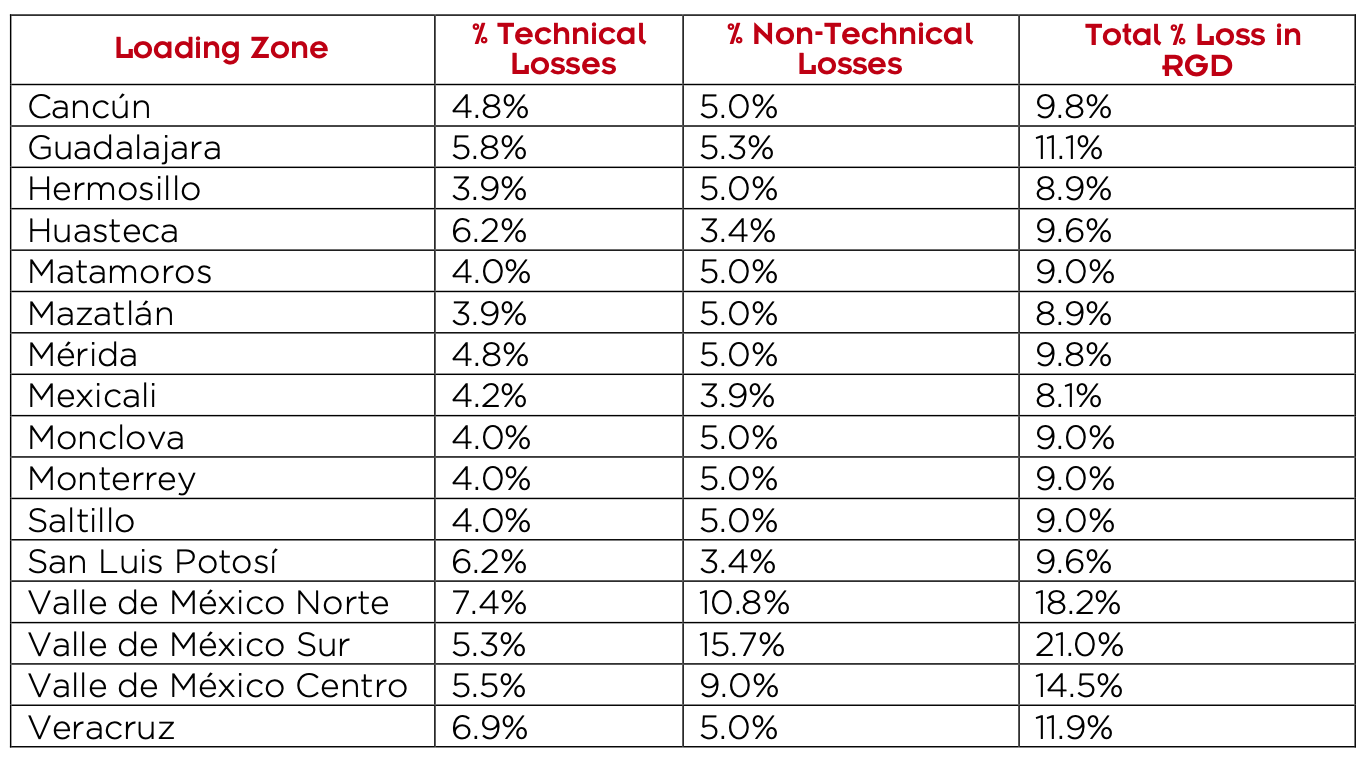The Impact of Electrical Losses on a Customers Service Bill

The “total losses of an electrical system” is a popular indicator for measuring the losses that occur during the transmission and distribution (T&D) of electricity from the generating plants point of interconnection with the National Electric System (which is where it receives electricity). Today, CFE provides the energy to the points of purchase (which we call connection points. Unfortunately, the total losses of the system are the equivalent to the difference between the power (GWh) supplied for consumption within the country and the power (GWh) billed to end users.
System losses are identified in two categories: (1) “Technical losses” (for example, heat losses, magnetic losses, or transformation losses) and (2) “non-technical losses” (for example, failure with the meter, bad handling, fraud, illegal or unmetered connections (commonly called “devils”), or billing data encryption losses, business losses, meter failures, and theft.
Electricity must be conducted from large power plants to consumers through transmission networks, which requires them to go through various stages of transformation to lower or raise the tension level (voltage) and finally, through the distribution network, to reach consumers connections and be recorded on their meters. The transmission of electricity over long distances generates energy losses.
Electrical energy is converted into heat through resistive losses irreversibly
Most of the electricity losses come from the “Joule effect” in transformers and power lines, which is a phenomenon that occurs when the moving electrons of an electric current impact against the material through which they are being conducted. The kinetic energy that the electrons have is then converted into thermal energy, heating the material through which they circulate.
Electricity losses occur at every stage of the transmission and distribution system, starting with the step-up transformer that connects the power plant to the transmission system ending at the end user.
According to the document “Efficient Electrical Energy Transmission & Distribution” edited by the IEC (International Electrotechnical Commission), the average value of power losses in the different stages under normal operating conditions are:

The “optimal” range of system losses varies from system to system, but total system losses generally range from 7% to 10% in developed countries, while in developing countries such as some in the African conti- nent, they are around 30% and 50%.
In August of 2022, the value of energy losses reported by the Federal Electricity Commission were 11.46% in high voltage and 13.74% in medium voltage. In the second trimester of this year, an improvement in the value of losses was observed, reversing the increase that occurred in 2020. To maintain the downward trend, the report indicates that energy recovery strategies have been reinforced throughout the country, in addition to the fact that they are registering a recovery in sales due to the gradual improvement of the economy.
The impact on the settlements of the National Center for Energy Control (CENACE)
CENACE is the entity responsible for estimating the real losses in the National Electric System (SEN) considering the energy measurements recorded by the Transporters, Distributors and the Entities Responsible for Loading.
These estimates serve as the basis for settling the transactions carried out in the Wholesale Electricity Market. The estimate of real losses in the National Transmis- sion Network (RNT) refers to the hourly losses in the SEN on an operation day and these are calculated as the difference between the energy injected and the energy withdrawn by the Load Responsible Entities. Many specialists also refer to it colloquially as the gross energy injected into the system and the net energy consumed, the difference being the energy that was “lost” in the conduction and transformation process.
These calculations are made in accordance with the Measurement Manual for Set- tlements, which indicates that CENACE will calculate the Technical and Non-Tech- nical Losses in the General Distribution Networks (RGD) in accordance with the Market Bases, integrating a report periodically with the results that have been observed in each Loading Zone.
Based on the above, CENACE reported 1.83% as an average of losses in the RNT in the period from Sep- tember 1 to October 24, 2022.
In the same period, the same agency reported the following losses in the RGD from the RNT to them in the following loading zones (extract):

Why is it important to know the evolution of the efforts to minimize the technical and non-technical losses of the electrical networks?
You should know that in the settlement process are calculated the abandoned and collected amounts by CENACE from market participants for the different types of charges included in the Day-Ahead Market, in the Real Time Market, in the Market for the Power Balance, in the Clean Energy Certificates Market, as well as in the services regulated by the Energy Regulatory Commission (CRE) and other charges, costs, income and credits
established in the Market Rules.
To inform market participants of the information on the settlement process, CENACE issues Daily Account Statements to each member of the Electricity Industry. With this information, the members of the Electricity Industry, as well as CENACE, can issue the corresponding payment invoices.
In simple terms, the fact of having losses in the networks represents for con- sumers, an economic cost overrun in our electricity billing, impacting our competitiveness, especially if we have our consumption in regions where technical and non-technical losses are superior to those of our own competi- tion, which is why we must seek, as a country, to have more efficient with electrical networks and transformation elements. Given the above, it is there- fore important that all market participants comply with the network code, because eventually this will allow for more precise measurements, which will also help to better calculate technical losses.
The process of migrating from the Basic Service to the Market is not simple, much less simple, so it is important to have the help of an expert who considers these variables together with many others. Remember that many supply offers that seem to be attractive in a high-level evaluation when it comes to detailing the subject of technical losses, could cease to be so.
We invite you to visit our website www.acclaimenergy.com.mx where you can request a meeting with one of our representatives to help address your questions or navigate through this process with the help of an energy expert.




